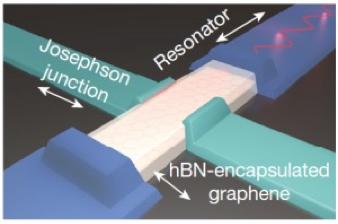The most sensitive and fastest graphene microwave bolometer

Schematics of the device, which consists of a graphene Josephson junction, which is integrated into a microwave circuit.
Credit: harvard-icfo-mit-bbntechnologies-nims
Bolometers are devices that measure the power of incident electromagnetic radiation thru the heating of materials, which exhibit a temperature-electric resistance dependence. These instruments are among the most sensitive detectors so far used for infrared radiation detection and are key tools for applications that range from advanced thermal imaging, night vision, infrared spectroscopy to observational astronomy, to name a few.
Even though they have proven to be excellent sensors for this specific range of radiation, the challenge lies in attaining high sensitivity, fast response time and strong light absorption, which not always are accomplished all together. Many studies have been conducted to obtain these higher-sensitivity bolometers by searching to reduce the size of the detector and thus increase the thermal response, and in doing so, they have found that graphene seems to be an excellent candidate for this.
If we focus on the infrared range, several experiments have demonstrated that if you take a sheet of graphene and place it in between two layers of superconducting material to create a Josephson junction, you can obtain a single photon detector device. At low temperatures, and in the absence of photons, a superconducting current flows through the device. When a single infrared photon passes through the detector, the heat it generates is enough to warm up the graphene, which alters the Josephson junction such that no superconducting current can flow.
So you can actually detect the photons that are passing through the device by measuring the current. This can be done basically because graphene has an almost negligible electronic heat capacity. This means that, contrary to materials that retain heat like water, in the case of graphene a single low-energy photon can heat the detector enough to block the superconducting current, and then dissipate quickly, allowing the detector to rapidly reset, and thus achieving very fast time responses and high sensitivities.
Trying to take a step further and move to higher wavelengths, in a recent study published in Nature, a team of scientists which includes ICFO researcher Dmitri Efetov, together with colleagues from Harvard University, Raytheon BBN Technologies, MIT, and the National Institute for Material Sciences, has been able to develop a graphene-based bolometer that can detect microwave photons at extremely high sensitivities and with fast time responses.
Just like with the infrared range, the team took a sheet of graphene and placed it in between two layers of superconducting material to create a Josephson junction. This time, they went an entirely new route and attached a microwave resonator to generate the microwave photons and by passing these photons through the device, were able to reach an unprecedented detection levels. In particular, they were able to detect single photons with a much lower energy resolution, equivalent to that of a single 32 Ghz photon, and achieve detection readouts 100.000 times faster than the fastest nanowire bolometers constructed so far.
The results achieved in this study mean a major breakthrough in the field of bolometers. Not only has graphene proven to be an ideal material for infrared sensing and imaging, but it has also proven to span to higher wavelengths, reaching the microwave, where it has also shown to attain extremely high sensitivities and ultra-fast read out times.
As Prof. at ICFO Dmitri Efetov comments “such achievements were thought impossible with traditional materials, and graphene did the trick again. This open entirely new avenues for quantum sensors for quantum computation and quantum communication”.
###
ABOUT ICFO
ICFO was founded by the Government of Catalonia and the Universitat Politècnica de Catalunya (UPC), both of which are members of its board of trustees along with the Cellex and Mir-Puig Foundations, philanthropic entities that have played a critical role in the advancement of the institute. Located in the Mediterranean Technology Park in the metropolitan area of Barcelona, the institute currently hosts 400 people, organized in 25 research groups in 60 state-of-the-art research laboratories. Research lines encompass diverse areas in which photonics plays a decisive role, with an emphasis on basic and applied themes relevant to medicine and biology, advanced imaging techniques, information technologies, a range of environmental sensors, tunable and ultra-fast lasers, quantum science, photovoltaics and the properties and applications of nano-materials such as graphene, among others. In addition to three state awarded Severo Ochoa accreditations of excellence, ICFOnians have secured 15 ICREA Professorships and 37 European Research Council grants. ICFO is proactive in fostering entrepreneurial activities, spin-off creation, and creating collaborations and links between industry and ICFO researchers. To date, ICFO has helped create 8 start-up companies.
Media Contact
All latest news from the category: Materials Sciences
Materials management deals with the research, development, manufacturing and processing of raw and industrial materials. Key aspects here are biological and medical issues, which play an increasingly important role in this field.
innovations-report offers in-depth articles related to the development and application of materials and the structure and properties of new materials.
Newest articles

Parallel Paths: Understanding Malaria Resistance in Chimpanzees and Humans
The closest relatives of humans adapt genetically to habitats and infections Survival of the Fittest: Genetic Adaptations Uncovered in Chimpanzees Görlitz, 10.01.2025. Chimpanzees have genetic adaptations that help them survive…

You are What You Eat—Stanford Study Links Fiber to Anti-Cancer Gene Modulation
The Fiber Gap: A Growing Concern in American Diets Fiber is well known to be an important part of a healthy diet, yet less than 10% of Americans eat the minimum recommended…

Trust Your Gut—RNA-Protein Discovery for Better Immunity
HIRI researchers uncover control mechanisms of polysaccharide utilization in Bacteroides thetaiotaomicron. Researchers at the Helmholtz Institute for RNA-based Infection Research (HIRI) and the Julius-Maximilians-Universität (JMU) in Würzburg have identified a…



